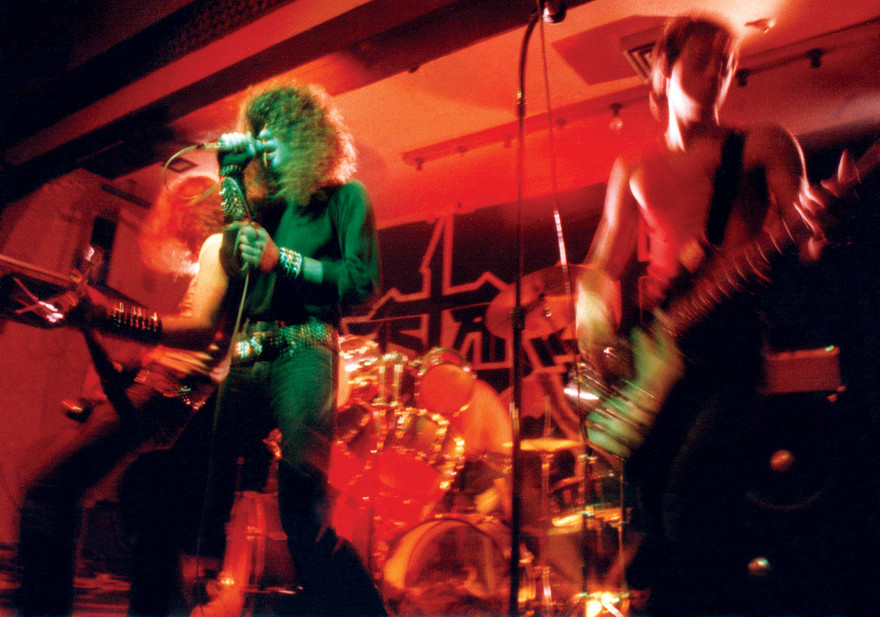
Tyrant in action, Wellington. - Iain Wood Collection
Wellington, 1980. I’ve just seen Strikemaster play the Terminus and my guitarist mate George tells me someone has stolen his leather jacket. We go running onto the street and see the guy head to Courtenay Place. George takes off running, I follow and watch as George jumps and – with a flying kick – knocks this guy out. At the exact same moment a police car was cruising past. They look at George, he yells “This arsehole stole my jacket!” The cops just laugh and they keep driving.
When you went to a gig in town you never knew if you were going to make it home in one piece. Although with friends like that, it was always an event.
The Terminus, on the corner of Taranaki Street and Courtenay Place, was literally just across the road from where I worked. My mates would turn up at 6pm and we’d play pool and pre-load on free booze while we waited for the doors to open. Not that we went every week – sometimes you had to wait months for the next band to play.
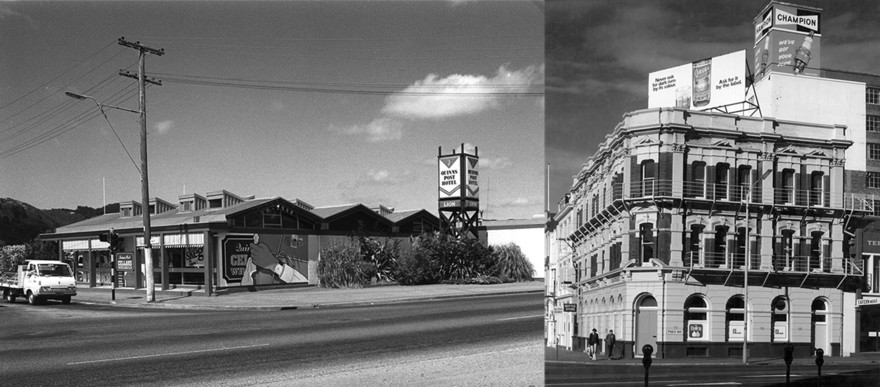
The Quinns Post Hotel, Upper Hutt, 1983; and The Terminus, on the corner of Taranaki St and Courtenay Place, 1978. - Upper Hutt Recollect P2-206-378; Wellington Recollect, Wellington City Libraries
Rose Bayonet would play the Terminus, but I only ever saw them out in Upper Hutt at the Quinns Post. But you could always rely on Strikemaster to play every so often. Wellington had one international heavy band visit in 1980 – KISS – and then nothing until Motorhead, Uriah Heep, and Deep Purple toured in 1984. Hardly the hotbed for a metal scene to be created.
The New Wave Of British Heavy Metal, which started in the UK in 1979, finally arrived in New Zealand around the middle of 1980. It inspired a few fans of this music to start bands. I formed the band Tyrant with Paul Martin (Knightshade/ Axe Attack/ Devilskin). Wellington is small, so you’d hear about other bands starting up, like Bronx and Deathwatch. We were all having the same issues getting venues to let us play so it wasn’t a surprise to find out when bands broke up, without playing a single gig.
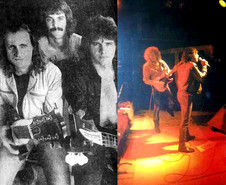
Strikemaster (left), and Tokyo
In 1981-82 the scene started to grow with more bands forming, such as Astaroth and Harlot. Also, bands visited from out of town with Stormbringer from Dunedin and Hamilton’s Knightshade playing relatively regularly. No one ever used support bands so for the smaller bands like us it was hard to get a leg up, but these gigs were full of members of other bands and you’d find out the latest gossip. It also wasn’t all that surprising to wake up the day after a gig and find the band and crew asleep on the living room of my flat – as they hadn’t booked anywhere to stay and were relying on friends up and down the country for somewhere to crash after every gig.
We would get booked to play places but found it hard to get another gig, even if the reviews were positive and the crowds were a decent size. We’d try everything and everywhere with no luck. We had gigs at the Clyde Quay, a support slot at the Cricketers, the University bar, and the opening slot at a Radio Windy open-air summer concert. We were lucky in that way.
We managed to get three gigs doing lunchtime gigs in high schools. The first of these, at Wellington Girls, was an experience. The hall was full, we played, and you’d think that was that, but no. First of all, we were asked to sign autographs. We thought they were having a laugh, but no. Worse was the school’s attempt to get the girls back in class. What followed was an hour of chaos as we tried to break the gear down while a steady stream of girls came back into the hall. When the headmistress complained about the disruption, we laughed, which I guess wasn’t the reaction she was looking for. She had the other two schools cancel the coming gigs. This kind of chaos was to follow us everywhere we went.

Blitz (left), and Harlot: in the early 80s the Wellington metal scene began to grow
Things really took off in Wellington in 1983. First off, we found a venue that allowed us to play regular gigs. We played Cosgroves, with Harlot as the support band for the first of many gigs there. But with the cost of PA and hiring lights, we made very little money. So we had an idea of bringing in other bands to spread the costs and had a rotating setup between us, Harlot, and Astaroth.
One would go on first on the Friday and the other on the Saturday. We’d toss a coin if we had a Thursday gig added. The one constant was that Tyrant played every time. We had some T-shirts printed for the band and people started asking if they could get one, so we printed some up and sold them at the gigs. We put up posters advertising the gigs, and one thing I could never figure out was how come we ended up covered in more paste than the posters, but it was always fun and not a chore. You had to keep an eye out for the cops as you went round town because you needed a licence to do it and, guess what, we didn’t have one.

The Godzone Metal compilation was released by Shane Joyce (right) and Steve Britland in 1983; "Stuff the speakers and let the volume rip!" said Rip It Up's review
Shane Joyce and his friend Steve Britland released the compilation Godzone Metal from recordings Shane had made at some of the Cosgroves’ gigs and a Rose Bayonet gig he had taped in 1980. For a glorified bootleg it now sells for a lot of money, especially in Europe, and I still get contacted by collectors looking for a copy. Shane became my flatmate and one day I came home from work and found Martin Heaps, the keyboard player for Stormbringer, setting up a bed in our laundry thanks to an invite from Shane.
We had a gig in Masterton with Astaroth, kind of testing the waters before trying our luck in Auckland. Both nights the place was packed with happy punters, but when we went in on the Sunday to unpack and collect the money it was about $200 short of the agreed amount. This, explained the manager, was because none of us were in the Musicians’ Union – and he said he didn’t have to pay us anything if he chose to. What could you do but take it on the chin?
The Whanganui gigs were a bust but somehow we managed to get a police escort out of town on the Sunday
Bayonet always had good crowds in Whanganui, so we tried our luck there next. The gigs were a bust but somehow we managed to get a police escort out of town on the Sunday. They told us never to come back again. We had invited some of the crowd back to the motel on the Saturday night and mysteriously all the letter boxes in the surrounding streets went missing that night, along with the motel street sign. I found the sign in the shower – don’t ask – and we had a fun time smuggling that out of the room with the motel manager watching us. He’d called the cops, and they searched the room but luckily for us not the van. I’ve no idea about what happened to the letterboxes though. Banned from Whanganui: how very rock’n’roll.
Finding new band members when one left was always a mission so when our bass player announced he was moving to the UK, we wanted to get some songs recorded quickly before he departed. Through my work in advertising, I had met Rocky Douché, the owner of Marmalade studio, and by coincidence Paul had been placed there on a work placement scheme.
We managed to get some time in the studio at a discount and the use of Ian Morris from Th’ Dudes as our engineer. Having previously recorded some demos in Crescendo Studios in Miramar we knew what to expect so, this time round, we worked on the arrangements of the songs before going in. We even had tapes of what we wanted the drums and guitars to sound like. Maybe we over-prepared as we finished ahead of time. The gear had been dismantled so we wondered what to do in the remaining time. We did the classic metal thing and made a backwards track, as a joke. Ian was really into this as he hadn’t done it before. It’s had some funny comments on YouTube as a result.
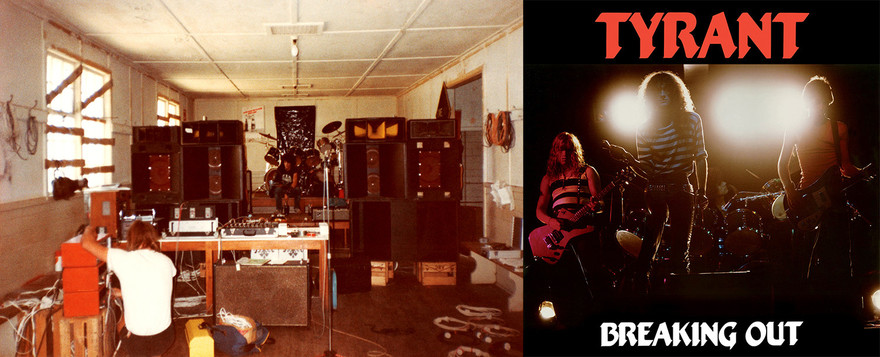
Tyrant's rehearsal room and the picture sleeve of their 12" EP Breaking Out (Tyrant Records, 1984)
We had 1000 EPs pressed and then set about trying to get a distribution deal. The manager of the Cuba Mall EMI store was keen to take as many as we would give him, to ship around the country. We had already approached Jayrem Records and been turned down.
Things wouldn’t go smoothly though. The EMI guy got fired the week we got the covers from the printer. The new guy didn’t like metal so backtracked on the deal. So we formed Tyrant Records and sold them ourselves. I’ve seen it selling in Real Groovy for $550 and I sold the last 25 copies to a German collector for way more than it cost us to make it. Around the same time that we recorded our EP, Shane released the Rose Bayonet album Leather and Chains.
Blitz were now playing at the Terminus, as were Tokyo (featuring Stefan Lavington from Rose Bayonet), and us. With Harlot and Astaroth playing at Cosgroves, the metal scene had truly taken off. For a while, anyway. Cosgroves stopped having bands, Astaroth and Harlot both split up, Tyrant was regrouping following the loss of our bass player. Knightshade still played regularly.
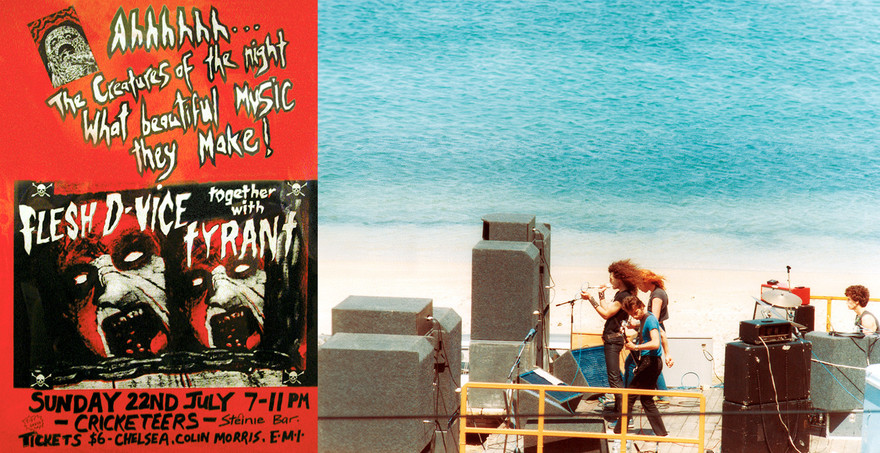
Flesh D-Vice and Tyrant play the Cricketers on the Sabbath, 1984; and Tyrant beside the seaside (and behind their speaker stack)
We finally played the Cricketers Arms in a co-headlining gig with punk band Flesh D-Vice. The Cricketers was such a success that we were asked to support Strikemaster at the Quinn’s Post and, a couple of months later, to headline on our own. But before that there was the Three Points of Metal show in Newtown, a co-production between Radio With Pictures and Jayrem Records with Tokyo, Strikemaster and Knightshade playing, screened later on Radio With Pictures. (Was I pissed off at not being on the bill? Of course, but those three bands had records out through Jayrem and this was a Jayrem/TVNZ show, so I wasn’t expecting to be invited.) Off the back of that concert, though, another was arranged in the Lower Hutt’s Horticultural Hall with us replacing Tokyo this time around and a distinct lack of cameras.
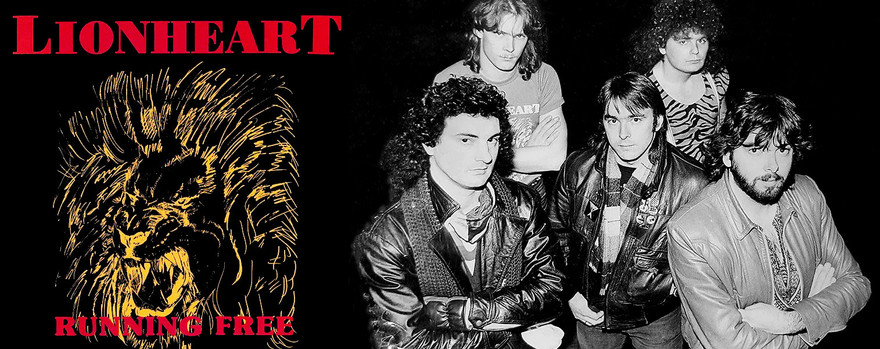
Lionheart's Running Free album (Jayrem, 1985), and a promo shot of the band.
Around the middle of 1985 Tyrant split up and Paul Martin joined Knightshade. The scene was still going strong with new bands Lionheart and Madlight playing the Terminus regularly, along with Blitz and Tokyo. I left town for London and later that year Lionheart would release the Running Free album on Jayrem. In 1986 Blitz released the ‘Key To Your Heart’ single and Jayrem put out the Attack from Downunda and 3 Points of Metal compilation albums.
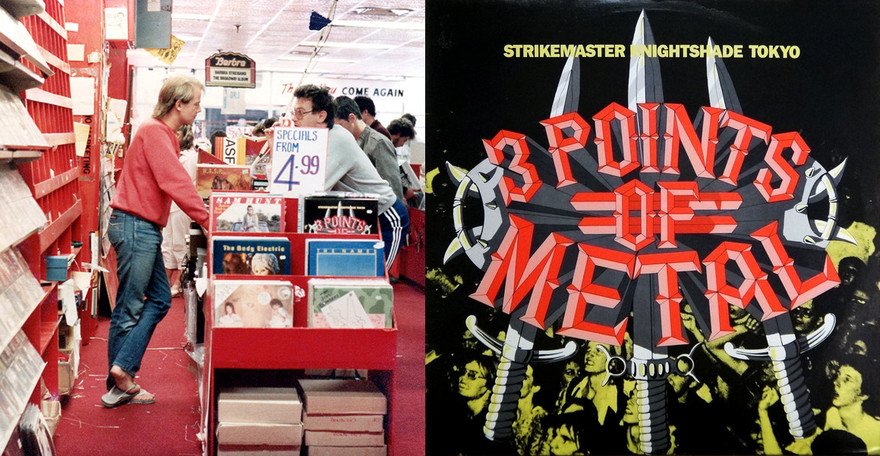
Chelsea Records, Wellington, c. 1986, with John Mowatt at the counter. In a special Jayrem display, the 3 Points of Metal compilation can be seen alongside The Body Electric, Rick Bryant and the Jive Bombers, and Sam Hunt. - Kevin Kane collection
I’d consider the peak of the metal scene in Wellington was 1984 to mid-1985 (until a little band called Shihad popped up, that is). By mid-1986 there would be only Lionheart and Madlight still playing.
Before I moved to the UK though, in 1986 the Terminus building was sold to developers. The last night it was open became notorious for two reasons. Wellington then had a problem with street kids, and we were always having fights with them. On this night one of our friends turned up and said he’d just been beaten up in Pigeon Park by some street kids.
The pub emptied out onto the street and there was a massive fight between us and the street kids. After it was over, and everyone was back in the bar, the cops turned up in force. They had driven a bus up to the venue’s doors and we were marched out onto the bus and taken down to the cells for questioning.
At least Wellington’s all-time home of heavy metal went out with a bang.
--
Metal bands, from Wellington and beyond, 1980-1981
Rose Bayonet (Wellington) – Geoff Dunn, vocals; Stefan Lavington, guitar; Matthew Hudson, bass; Jerry Pearse-Smith, drums
Strikemaster (Wellington) – Steve Elliott, vocals and bass; Paul Cullen, guitar; Brian Desmond, drums
Tyrant (Wellington) – Woody, vocals; Paul Martin, guitar; Matthew Beauchamp, bass; Colin Wood, drums
Harlot (Wellington) – Damon Morton, vocals; William Arthur, guitar; Colin Smith, bass; Andy Maitland, drums
Astaroth (Wellington) – Stuart Parkinson, vocals; John Parker and Dave Goodger, guitars; Mark Elphick, bass; John Glocking, drums
Blitz (Wellington) – Gary Shanks, vocals; Richard Offoskie, guitar; Dave Broad, bass; Steve Wright, drums
Tokyo (Wellington) – Charles Schultz, vocals; Stefan Lavington, guitar; Barry White, bass; Pat McLaughlin, drums; Scott Wylie, keyboards
Madlight (Wellington) – Steve Hall, vocals; Terry Potter, guitar; Chris Ewers, bass; John Derwin, drums; Roger Collinge, keyboards
Lionheart (Wellington) – Andy Clannican, vocals; Rudy Garrow, guitar; Mark Brimblecombe, bass; Larry Leach, drums
Dead Image (Auckland) – Allan Stevenson, vocals; Mathew Ahern, lead guitar; Tony Chandler, bass; Billy Williams, drums; Ian Baker, guitar
Confessor (Auckland) – Davey Strange, vocals; Daniel E Thomas, guitar; Fui Van Gal, guitar; Dazzle, bass; Xavier Mettrick, drums, percussion
Knightshade (Hamilton) – Wayne Elliott, vocals; Gavin Lind and Rik Bernards, guitars; Jon Bell, bass; Alan Grady, drums
Stonehenge (Hamilton) – Djamil Rodop, vocals; Ashley Barton, guitar; Anton Jelicich, guitar; Phil Drake, bass; Carl Mackie, drums
Fat Sally (Christchurch) – Keith Palmer, bass, vocals, keyboards; Darryl Pringle, guitar; Kevin Emmett, drums
Stormbringer (Dunedin) – Pete Weeda, vocals; Lee Woods, guitar; Gary Ross McIntosh, bass; Andrew Aquitters, drums; Martin Heaps, keyboards
Key releases, 1980-1986
Godzone Metal (compilation LP, NZ Metal, 1983) – Rose Bayonet: Demon Rider / Let It Die. Harlot: School Girls / Another Day / Dancing On My Mothers Grave. Tyrant: Surprise / Bedroom Secrets / Nowhere To Run. Astaroth: 1066 / Demon Dance / Astaroth
3 Points of Metal (compilation LP, Jayrem, 1984) – Knightshade: Free Love / Livin’ a Lie / Pay the Price / Reach For Da Sky. Strikemaster: Better Ways / Intro / Johnny. Tokyo: Tough Road
Rose Bayonet – Leather and Chains LP (NZ Metal, 1984): Death Rattle / Let It Die / Blow Me Away / Demon Rider / Leather And Chains / Demon Rider (live) / Let It Die (live) / Night Fighters (live) / Hell On Earth (live) / Predator (live) / Out Of The Tower
Strikemaster – So Many Faces / Your Time Has Come (7" single); Good’n’Ready LP (Jayrem, 1984): Time is on My Side / Standing Alone / Good’n’Ready / Hey You / Let Me Go / The Grind / Wellington / Who Can I Turn To / It’s Not My Fight
Tyrant – Breaking Out (12" EP, Tyrant Records, 1984): Sorry / Backwards / Nowhere To Run / Breaking Out; Don’t Get Me Wrong / Pieces Of Hate (demo tape)
Dead Image – Ors Well in 1984 (12" EP, Onslaught, 1984): Change / Schitzophrenic / Shadows / Numbers Up
Lionheart – Running Free LP (Jayrem, 1985): Fallen Angel / Fathers Tale / Hell Hound / Hard Luck Woman / Running Free / Mindless Power / Leave It Out / Witch Queen / On The Road
Confessor – First Sin (12" EP, Jayrem, 1985): Soldier of Hate / Satin Sheet Action / No Peace for the Wicked
Tokyo – I Rock You / Lonely Hearts (12" single, Jayrem, 1985)
Stormbringer – Life Sentence LP (Jayrem, 1986): Bridge Crusher / Hold On Take Me Down / Life Sentence / Hit The Road / Silver Rain / Self Destruct
Blitz – Key To Your Heart / On The Run (7" single, Jayrem, 1986)
Attack From Downunda (compilation LP, Receiver Records UK, 1986) – Knightshade: Blood and Money; Confessor: No Peace For The Wicked; Strikemaster: So Many Faces; Stormbringer: Bridgecrusher; Tokyo: Lonely Heart; Strikemaster: Your Time Has Come; Knightshade: Free Love; Stonehenge: Burnin’ Fever; Stormbringer: Self Destruct; Blitz: Key To Your Heart
Stonehenge – Wings of Steel (12" EP, Jayrem, 1986): Wings of Steel / Burning Fever / Easy Livin’
Knightshade – Out For The Count / Free Love / Heart Of Stone / Blood and Money (12" EP, Reaction, 1986); Out For The Count Live! LP (Reaction, 1987): Sheila at the Wheel / Blood and Money / Out For The Count / Finders Keepers / No, No, No / Make Up Your Mind / Spring Twice / No Grass / Caroline
Fat Sally – Shadow of the Night (12" EP, EMI, 1987): Today’s Pressure / The Assassin / On the Run / Warriors Bold / Shadow of the Night
Madlight – Rock Lies (Bad Taste soundtrack, QDK Media, Germany, 1990)
--
Read more: Ten Moments in New Zealand Metal